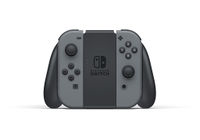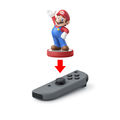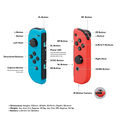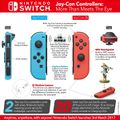| Site Notice |
|---|
|
We have a limited coverage policy. Please check our coverage page to see which articles are allowed. |
Difference between revisions of "Joy-Con"
m (→Features and functionality) |
m (→Features and functionality) |
||
| Line 14: | Line 14: | ||
The controllers feature the same buttons in an asymmetrical layout. Each Joy-Con has an analog control stick that can be pressed, a set of "face buttons" (the standard A/B/X/Y buttons on Joy-Con R, and a set of d-pad buttons on Joy-Con L), and a digital shoulder button and trigger button on the back. The backs of the Joy-Con also feature buttons to remove the Joy-Con from the Nintendo Switch or Joy-Con Grip. On the tops are the plus (Joy-Con L) and minus (Joy-Con R) buttons. On the side are player indicator LEDs, a pair of additional "SL" and "SR" shoulder buttons when using the Joy-Con as individual controllers, and a sync button to connect the controllers to the console when held<ref name="Presentation"/><ref name="features">[http://www.nintendo.com/switch/features/ Features] on the official Nintendo Switch website. Retrieved January 13, 2017.</ref> that also acts as a power button when pressed.<ref>[http://www.nintendolife.com/news/2017/05/video_nintendo_switch_controllers_all_have_a_power_button_hiding_in_plain_sight Video: Nintendo Switch Controllers All Have a Power Button Hiding in Plain Sight]. Nintendo Life (May 4, 2017). Retrieved May 5, 2017.</ref> A pair of Joy-Con Straps (HAC-014) can also be attached, which feature a wrist strap in addition to the SL and SR buttons and player LEDs. | The controllers feature the same buttons in an asymmetrical layout. Each Joy-Con has an analog control stick that can be pressed, a set of "face buttons" (the standard A/B/X/Y buttons on Joy-Con R, and a set of d-pad buttons on Joy-Con L), and a digital shoulder button and trigger button on the back. The backs of the Joy-Con also feature buttons to remove the Joy-Con from the Nintendo Switch or Joy-Con Grip. On the tops are the plus (Joy-Con L) and minus (Joy-Con R) buttons. On the side are player indicator LEDs, a pair of additional "SL" and "SR" shoulder buttons when using the Joy-Con as individual controllers, and a sync button to connect the controllers to the console when held<ref name="Presentation"/><ref name="features">[http://www.nintendo.com/switch/features/ Features] on the official Nintendo Switch website. Retrieved January 13, 2017.</ref> that also acts as a power button when pressed.<ref>[http://www.nintendolife.com/news/2017/05/video_nintendo_switch_controllers_all_have_a_power_button_hiding_in_plain_sight Video: Nintendo Switch Controllers All Have a Power Button Hiding in Plain Sight]. Nintendo Life (May 4, 2017). Retrieved May 5, 2017.</ref> A pair of Joy-Con Straps (HAC-014) can also be attached, which feature a wrist strap in addition to the SL and SR buttons and player LEDs. | ||
| − | Both Joy-Con have built-in accelerometers and gyroscopes for more advanced motion control.<ref name="Presentation"/> Another new feature of the Joy-Con is "HD Rumble", a more advanced form of haptic feedback powered by {{wp|Immersion Corporation}}'s "LRA" (linear resonant actuator) technology, allowing users to feel more precise sensations.<ref name="Presentation"/> Joy-Con L features a new Capture Button, which allows users to capture screenshots of gameplay and | + | Both Joy-Con have built-in accelerometers and gyroscopes for more advanced motion control.<ref name="Presentation"/> Another new feature of the Joy-Con is "HD Rumble", a more advanced form of haptic feedback powered by {{wp|Immersion Corporation}}'s "LRA" (linear resonant actuator) technology, allowing users to feel more precise sensations.<ref name="Presentation"/> Joy-Con L features a new Capture Button, which allows users to capture screenshots of gameplay or (as of version 4.0.0 system update and only in compatible software) capture video clips by holding the button down, which can be shared on social media.<ref name="Presentation"/> Joy-Con R also has a built-in {{wp|Near field communication|NFC}} reader and writer,<ref name="Presentation"/> and its bottom is an IR camera which can detect the shapes of objects and their distance from the Joy-Con.<ref name="features"/><ref name="Presentation"/> |
The Joy-Con use a rechargeable lithium-ion battery (HAC-006<ref>[http://gonintendo.com/stories/274914-random-time-user-showcases-the-inside-of-a-nintendo-switch-joy Random Time! - User showcases the inside of a NIntendo Switch JoyCon]. GoNintendo (February 28, 2017). Retrieved February 28, 2017.</ref>) which lasts for up to 20 hours at full charge. The Joy-Con can be charged by attaching them to the Nintendo Switch system (regardless of whether or not it is charging), or by using the Joy-Con Charging Grip (HAC-012).<ref name="Presentation"/> | The Joy-Con use a rechargeable lithium-ion battery (HAC-006<ref>[http://gonintendo.com/stories/274914-random-time-user-showcases-the-inside-of-a-nintendo-switch-joy Random Time! - User showcases the inside of a NIntendo Switch JoyCon]. GoNintendo (February 28, 2017). Retrieved February 28, 2017.</ref>) which lasts for up to 20 hours at full charge. The Joy-Con can be charged by attaching them to the Nintendo Switch system (regardless of whether or not it is charging), or by using the Joy-Con Charging Grip (HAC-012).<ref name="Presentation"/> | ||
Revision as of 20:32, 2 January 2018
| Joy-Con | ||||||||
|---|---|---|---|---|---|---|---|---|
| ||||||||
|
The Joy-Con (Joy-Con (L) and Joy-Con (R)) are the primary controllers for the Nintendo Switch. Their main feature is their versatility, able to be used as a singular controller both attached or detached from the Nintendo Switch itself and a controller grip, or as individual controllers.
Features and functionality
The Joy-Con are a pair of controllers that can be used as both a singular controller or as two controllers. The Joy-Con can be attached to the Joy-Con Grip (HAC-011) or the system by locking into the rails on both sides, or independently from both by holding them in each hand.[1][2]
The controllers feature the same buttons in an asymmetrical layout. Each Joy-Con has an analog control stick that can be pressed, a set of "face buttons" (the standard A/B/X/Y buttons on Joy-Con R, and a set of d-pad buttons on Joy-Con L), and a digital shoulder button and trigger button on the back. The backs of the Joy-Con also feature buttons to remove the Joy-Con from the Nintendo Switch or Joy-Con Grip. On the tops are the plus (Joy-Con L) and minus (Joy-Con R) buttons. On the side are player indicator LEDs, a pair of additional "SL" and "SR" shoulder buttons when using the Joy-Con as individual controllers, and a sync button to connect the controllers to the console when held[1][3] that also acts as a power button when pressed.[4] A pair of Joy-Con Straps (HAC-014) can also be attached, which feature a wrist strap in addition to the SL and SR buttons and player LEDs.
Both Joy-Con have built-in accelerometers and gyroscopes for more advanced motion control.[1] Another new feature of the Joy-Con is "HD Rumble", a more advanced form of haptic feedback powered by Immersion Corporation's "LRA" (linear resonant actuator) technology, allowing users to feel more precise sensations.[1] Joy-Con L features a new Capture Button, which allows users to capture screenshots of gameplay or (as of version 4.0.0 system update and only in compatible software) capture video clips by holding the button down, which can be shared on social media.[1] Joy-Con R also has a built-in NFC reader and writer,[1] and its bottom is an IR camera which can detect the shapes of objects and their distance from the Joy-Con.[3][1]
The Joy-Con use a rechargeable lithium-ion battery (HAC-006[5]) which lasts for up to 20 hours at full charge. The Joy-Con can be charged by attaching them to the Nintendo Switch system (regardless of whether or not it is charging), or by using the Joy-Con Charging Grip (HAC-012).[1]
Gallery
Using amiibo with the Joy-Con.
Trivia
- The name "Joy-Con" was derived from the word "enjoy".[6]
- An earlier iteration of the system used magnets to attach the Joy-Con for handheld mode, but this was changed to the rail design as the magnets would easily separate.[6]
- An early design for the Joy-Con Grip attached the controllers in a "V" shape. This was changed to the current, "parallel" design to make it easier to use.[6]
- Following the launch of the Nintendo Switch, a number of users reported issues regarding the left Joy-Con loosing connectivity when used wirelessly. According to Nintendo, the Joy-Con connectivity problems were the result of a "manufacturing variation", which has since been resolved.[7]
External links
References
- ↑ 1.0 1.1 1.2 1.3 1.4 1.5 1.6 1.7 Nintendo Switch Presentation 2017. Nintendo (YouTube; January 12, 2017). Retrieved January 13, 2017.
- ↑ First Look at Nintendo Switch. YouTube (Nintendo; October 20, 2016). Retrieved October 20, 2016.
- ↑ 3.0 3.1 Features on the official Nintendo Switch website. Retrieved January 13, 2017.
- ↑ Video: Nintendo Switch Controllers All Have a Power Button Hiding in Plain Sight. Nintendo Life (May 4, 2017). Retrieved May 5, 2017.
- ↑ Random Time! - User showcases the inside of a NIntendo Switch JoyCon. GoNintendo (February 28, 2017). Retrieved February 28, 2017.
- ↑ 6.0 6.1 6.2 5 Things You May Not Know About Nintendo Switch – Nintendo Minute Video. Nintendo (YouTube; February 24, 2017). Retrieved February 25, 2017.
- ↑ Nintendo Says JoyCon Wireless Issues Were Caused By 'Manufacturing Variation'. Kotaku (March 22, 2017). Retrieved March 24, 2017.
|
|












